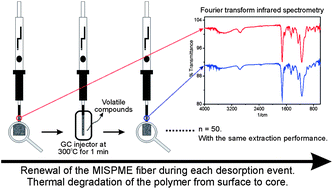Molecularly imprinted fibers with renewable surface for solid-phase microextraction of triazoles from grape juice samples followed by gas chromatography mass spectrometry analysis
Abstract
This paper describes the synthesis and characterization of a new molecularly imprinted solid-phase microextraction fiber able to renew its selective binding sites because of the gradual thermal decomposition of the polymeric network. The injector of the chromatograph operates at 300 °C, and during the desorption step of the analytes (in a short period), the polymeric network is degraded from the surface to the core in volatile compounds that do not interfere with the analysis. The renewable MIP fiber was successfully employed to extract triazole fungicides (triadimenol, tebuconazole, and metconazole) from grape juice samples followed by gas chromatography mass spectrometry analysis. The method was adjusted to the quadratic models from 100 to 2000 μg L−1, with good precision and accuracy. The limits of quantification (100 μg L−1 for all analytes) were sufficient to analyze triadimenol, tebuconazole, and metconazole in grape juice samples, where their maximum residue limits in Brazil are 100, 2000, and 1000 μg L−1, respectively.

- This article is part of the themed collection: Analytical Sciences in Brazil

 Please wait while we load your content...
Please wait while we load your content...